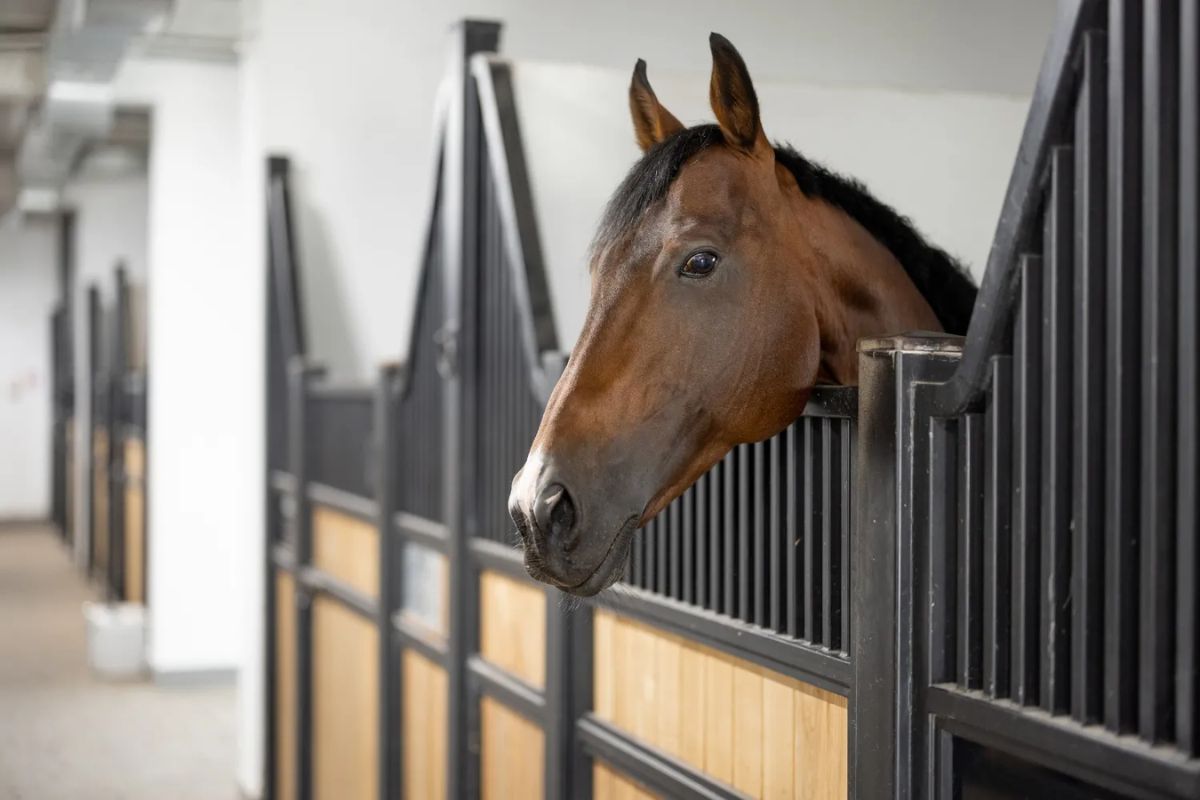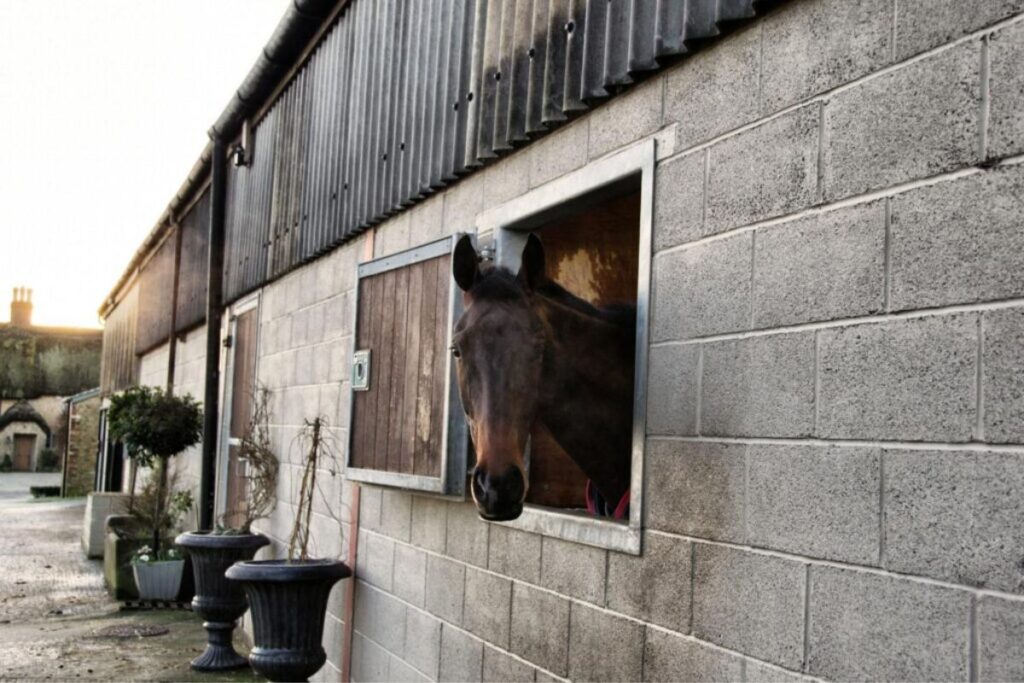Menu

Keeping your horse stabled can be convenient and easy. The horse is usually always clean and dry, it's easy to access, and as a horse owner, it's not pleasant to have to go out in all sorts of weather to catch the horse from the field. But is this also the best for the horse? And can we do better? French researchers have been taking a closer look, and their conclusion is not uplifting. Horses are social animals and they need to be in contact with other horses. Yet, the majority of all sport horses are kept in stables for many hours during the day. The renowned research institute INRA (L’Institut National de la Recherche Agronomique) has studied the horse's well-being when it is kept in a stable consisting of individual boxes. The aim was to identify which factors could mitigate the negative effects that arise from individual stabling.
Also check out: Give the horses an interesting paddock
"In equestrian sports, the consideration for the horse should be prioritised above all else. Everyone involved with horses should care for the horse's welfare and need for care and grooming, and the horse's well-being should take precedence over all other desires". This is what the Danish Equestrian Federation writes about their guidelines for the ethical use of the horse in equestrian sports. Despite this, according to the French study, 30-90% of all horses are kept in individual boxes, without the opportunity for physical contact with other horses. The researchers believe the main arguments may be that it is practical, it may be for safety, or because it may be more comfortable for the horse owner. There is a long and historical tradition for the use of individual stabling, and horse owners are often hesitant to change their stabling form, the researchers believe.
Since individual boxes are still the most popular way to stable horses, the researchers wanted to investigate how the environment around the horses could still be made as good as possible. Dr. Lea Lansade works for INRA, and she is a specialist in equine behaviour. Her research focuses primarily on the horse's personality, cognition and emotions, and very much on equine welfare. Lea Lansade and her colleagues studied 187 horses for 50 days to see if we could mitigate the negative effects by changing the stable design and the way we keep horses. Could changes in the design or horse care affect the occurrence of negative behaviour in the horse?
Dr. Lea Lansade defines welfare as the horse's adaptation to the surroundings, i.e., how easily it gets used to the conditions it lives under, and how much the surrounding environment affects the horse. Welfare refers to the horse's perception of environmental challenges. There are different ways to measure the horse's well-being. The researchers chose to look at four well-known behavioural patterns that have been used extensively in research and have been related to stabling in individual boxes. These behavioural patterns can greatly influence the horse's welfare.
The first behaviour the researchers looked at was stereotypic behaviour. This is a repetitive behaviour often seen in animals or humans who find themselves in situations where they are cut off from one or more of their natural needs. This is often seen in animals in captivity, due to inadequate space or lack of stimulation. Another behavioural pattern was aggression towards humans, which is seen both in young horses and adults. The third factor the researchers investigated was stress-related behavior, seen in the horse constantly being on guard and attentive to its surroundings. Unlike stress and aggression, horses that are stabled individually can also develop a form of depression, an indifference to their surroundings.
The fourth behavior type that the researchers looked at was an introverted depressive behavior. A horse that is indifferent and does not respond to its surroundings, has a particular body posture - with the neck at back height, a fixed gaze, and a static head and ear position. This special body posture reflects the horse's inner state and it resembles symptoms seen in humans suffering from depression. It can cause serious health damage in the long run, the researchers believe, but here and now it is a sign that the horse is not doing well. The researchers found that the older the horses were, and the longer the horses through their adult lives had been stabled individually, the more likely it was that they would show signs of depression, in the form of indifference and apathy towards the surroundings. More than five percent of horses between 16 and 20 years showed these signs, writes Lea Lansade in the report.
Also check out: Vet’s advice: Swollen jowls and legs often occur in early spring
To remedy the deficiencies caused by individual stabling, it was obvious to see if there were any factors surrounding the stabling that could alleviate the negative effects. The researchers pointed to 12 different factors that could potentially influence the horses. It could be special facilities in the box, such as access to a grid window, which allowed social contact. It could also be to increase the time the horses were ridden, it could be longeing or going in a walker. However, the results showed that it did not make any significant difference. Despite the researchers conducting three different analyses, they only found three out of the 12 different environmental factors that had a minimal impact on the horse's welfare when they were in individual boxes. A box strewn with straw, a window to the outside world, and less concentrated feed were the only things that had a small impact on the horse's behavior.
A window in the box appeared to affect the horse's frustration. An opening out to the surrounding environment, which allowed the horse to keep up with what was going on around it and the opportunity to see other horses, made a small difference. This result corresponds to previous studies, which suggest that a view of the outside world can help to reduce frustration in the horse, which often manifests itself in aggressive behavior towards humans. However, the researchers emphasized that a window in the box did not increase the horse's overall satisfaction with its situation.
Also check out: 3 bits that can really damage your horse

Another thing that affected the horse's welfare was the type of bedding used in the stable. Horses that stood on a straw bottom were less aggressive than the horses that stood on a bottom of sawdust, peat, or other material. Straw helps the horse to lay down better, it provides opportunities to explore the surroundings. At the same time, straw can be eaten, which fulfills the horse's natural need to graze around the clock. Straw in the box can therefore help a little to improve the behavioral and physiological needs that the horse has, and it could help to reduce frustration and potential pain.
The last thing that could affect the horse positively was to reduce the ration of concentrated supplementary feed. Concentrated feed increases the amount of stomach acid, and if the horse simultaneously receives limited amounts of roughage, this can increase the risk of gastric ulcers and the development of stereotypic behavior, according to researchers.
The researchers' conclusion was not exactly uplifting. Even though the three aforementioned factors had a positive effect on the horses, the effect was also limited, and the negative aspects of individual stabling were not outweighed by small changes, such as providing the horse with straw in the box or a window in the stable. The researchers suggest that more drastic changes in the living conditions for the horses are needed to improve their welfare and meet the horse's basic needs. The stable's design must allow free movement, interaction with conspecifics, and access to eat roughage as often as possible to ensure that the horse's behavioral and physical needs are met, the researchers conclude.
Also check out: Spring: When should the horse’s rug be removed?
Ruet, A.; Lemarchand, J.; Parias, C.; Mach, N.; Moisan, M.-P.; Foury, A.; Briant, C.; Lansade, L. Housing Horses in Individual Boxes Is a Challenge with Regard to Welfare. Animals 2019, 9, 621.